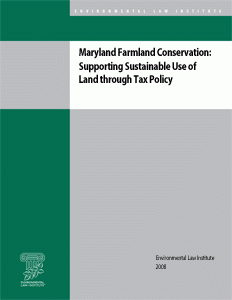
Maryland’s population is increasing rapidly while the state continues to lose its agricultural lands. This study explores Maryland’s primary tax measures affecting agriculture, the agricultural use assessment (AUA) and the agricultural land transfer tax (ATT), in order to determine whether these related tax programs could be improved in ways that would encourage farmland protection while continuing to benefit farmers’ bottom lines. ELI found that an effective policy response would be to (1) Increase the agricultural land transfer tax rate by an additional 0.5 - 2 percentage points and distribute the revenue from the increase to counties; or authorize those Maryland counties experiencing farmland loss to levy a county agricultural land transfer tax in that amount. Because farmland conversions are occurring at the fastest rate at the urban fringe, where farmland market values are generally high, the increased tax (whether state or county) will have the greatest effect on those counties whose landowners gained the most benefit from the AUA. (2) Close the loophole in the agricultural land transfer tax allowing limited liability corporations to avoid payment of the tax. (3) Maintain the agricultural use valuation only for farms that have complied with Maryland nutrient management and other requirements in order to reinforce the public benefit side of the program, and meet the water quality objectives of the Maryland’s Agricultural Stewardship Act.